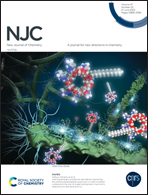A fluorometric graphene oxide-based assay for determination of agrB gene transcription in methicillin-resistant Staphylococcus aureus by coupling exonuclease III-assisted target recycling and hybridization chain reaction†
Abstract
A fluorometric graphene oxide (GO)-based assay was used to determine agrB gene transcription in methicillin-resistant Staphylococcus aureus (MRSA). This method is based on exonuclease III (Exo III)-assisted target recycling and hybridization chain reaction (HCR). A hairpin DNA probe (HP1) was designed to contain a capture probe (CP) and trigger probe (TP). Without a target, all of the carboxy-fluorescein (FAM)-labeled hairpins (HP2 and HP3) were adsorbed onto the surface of GO by π-stacking interactions, leading to the quenching of the dye. Upon addition of the target RNA, the 3′-strand of HP1 was cleaved stepwise by Exo III, accompanied by the release of the target RNA and autonomous generation of a new TP. The released target RNA hybridized to another HP1 and entered the next round of the reaction. TP initiated HCR with the assistance of HP2 and HP3 to generate a long double-stranded DNA (dsDNA) product. GO did not absorb the dsDNA product and produced strong fluorescence. Therefore, the target RNA was quantified by measuring the fluorescence at excitation and emission wavelengths of 480/514 nm. More importantly, fluorescence was greatly enhanced by exploiting the synergistic effect of FAM and the dsDNA-SYBR Green I (SGI) duplex structure. This bioassay exhibited good selectivity and high sensitivity with a linear response in the 10 fM and 1 nM target RNA concentration range and a 5.8 fM limit of detection (LOD). It was successfully used to monitor biofilm formation and to study the mechanism of drug action with satisfactory results.



 Please wait while we load your content...
Please wait while we load your content...